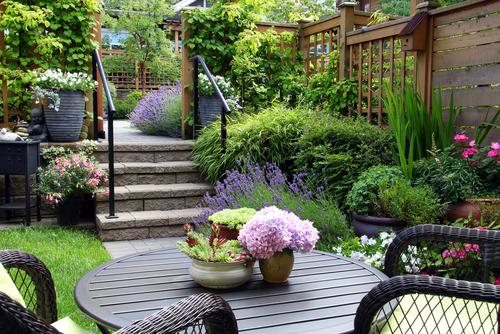
Making the Most of Small Gardens..
“There are always flowers for those who want to see them.” ~ Henri Matisse

A small garden does not need to mean small ambitions. Small spaces encourage you to be creative, and can herald stylish and dramatic results – the only obstacle is your imagination!
Smaller gardens are pleasingly low-maintenance and they create an outdoor room you can enjoy year-round. When designing a small space, the best approach is to be bold, opt for prominent features, and repeat elements to tie the design together.
Whether you have a small front garden, courtyard or balcony, you can create a space for solace and beauty with the proper planning and planting.
Try our top 5 tips to transform your garden.
1. Use Height


Layering height in a garden is essential for creating depth. Climbers are an excellent addition. They take up little space on the ground and add drama with their foliage and flowers. Climbers such as clematis, wisteria, and even some varieties of hydrangea and rose look exquisite when growing up obelisks and pergolas. They also create shade, help divide areas and create a perception of space.
Creating a living wall or hanging pots and plants from fences or partitions provide beautiful, ever-changing features which draw the eye and help enlarge the garden.
Remember, trees are not only for extensive country gardens. Many species of small trees can thrive in a smaller garden and, again, will help create a sense of space. Acers and fruit trees such as apple and cherry will look beautiful in a little garden whatever the season.
2. Clever Landscaping


Clever landscaping does wonders for a small garden, and a bit of design and creativity can go a long way. The trick here is to compartmentalise. You can create your very own secret garden with cosy hideaways, hidden areas, and meandering paths.
Using a combination of techniques is what makes this work. Try:
- Layering – layers work by adding the illusion of depth. Combining plants and shrubs of varying heights in both raised beds and ground-level beds adds height and creates the illusion of more foliage and space than there really is.
- Pathways and paving – a path adds instant depth, which lengthens and widens the size of your garden. Paths which are diagonal or at an angle can make a garden look more expansive, whereas long vertical paths create distance. Slightly raising a path or walkway will add height and make the ground level planting seem taller. Paths also add much-needed mystery and interest to a space that could have simply been a paved yard or small lawn.
- Textures – using a variety of textures is essential for giving your garden that much needed artistic flair and sense of style. Separating areas with different materials helps create that sense of intrigue and desire to explore. You can use different tones of gravel, various natural stone paving slabs, wooden decking or bridges, varying beds, and both lawn sections and water features.
To have so many elements in one space might sound chaotic and haphazard, but implementing them carefully will give you the garden of your dreams.
3. Use Mirrors


A garden mirror is a foolproof way of making a small garden look much bigger than it is. You can buy a mirror suitable for outdoor use from most garden centres and online stores; however, you could also make your own by using a piece of painted trellis mounted onto a mirrored board.
For the best results, place seating close by to enjoy a garden view whenever you sit down with a cup of tea.
4. Utilise Pots and Containers


Don’t forget the versatility of pots and containers, in which you can grow edible, seasonal, and ornamental plants. Using different sizes, shapes and colours adds texture and dynamism, and be sure to combine a variety of flowers, herbs, succulents, ferns and flowering shrubs.
If you have a balcony area or a small patio space, window boxes are a fantastic opportunity to inject a bit of colour and life.
The plants you choose to grow can flow easily with the seasons, and it allows you to select plants such as Camelias that do not grow so well in the ground.
5. Make an Outdoor Living Space


Creating an outside living area provides a sense of continuity between the indoors and outdoors and creates the illusion of more space and versatility. Dress your small garden with a stylish outdoor lounge or dining set to ensure it’s a space you want to spend more time in.
As this outdoor space is an extension of your home, it needs to be just as comfortable and aesthetically pleasing. Accessorise the same way you would indoors by incorporating rugs, cushions, throws, candles and ornaments. There is a wide range of outdoor accessories available, and you can always find a home for them inside if the weather turns.
No matter how small your garden is, you can create an area that makes the most of the space. Whether you want to create a pretty balcony garden, a courtyard lounge, a floral idyll, a kitchen garden to harvest, or a plot full of greenery, there are endless creative possibilities at your fingertips. Which will you try?